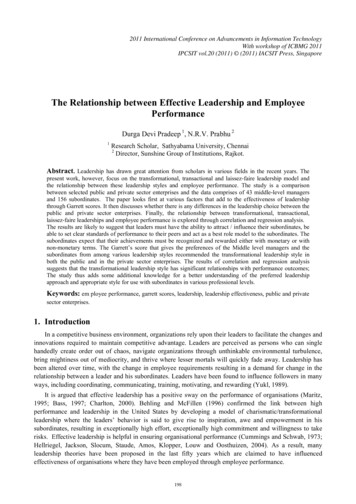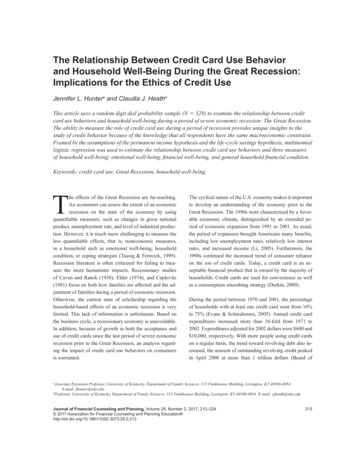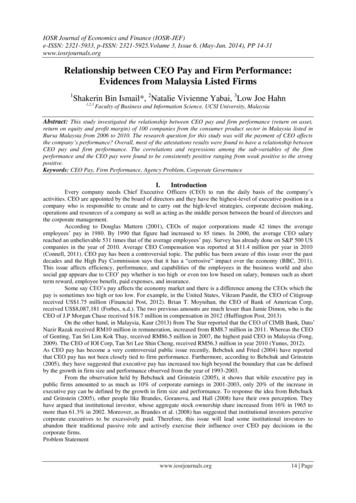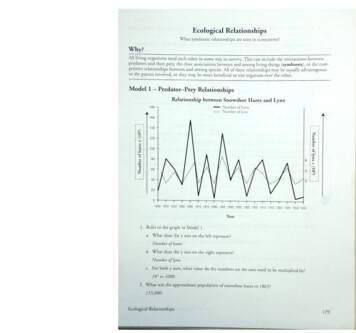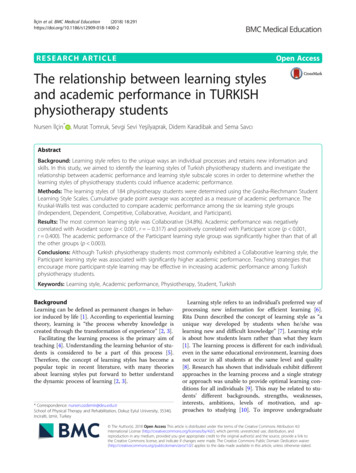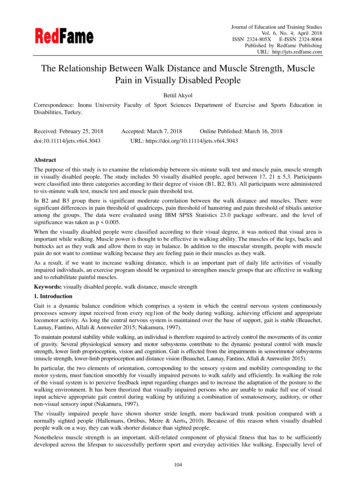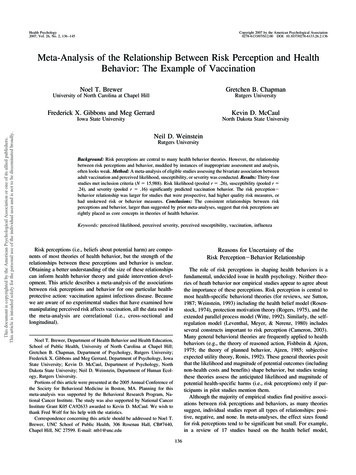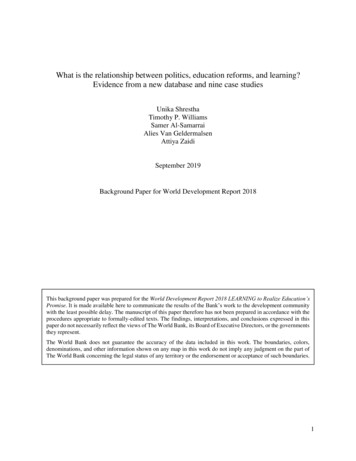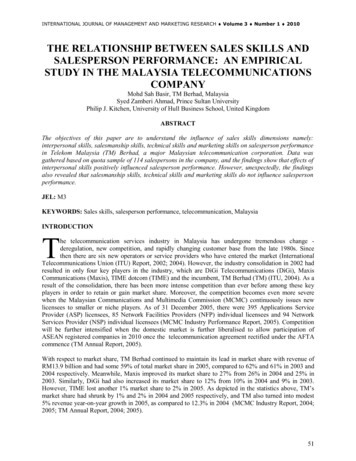
Transcription
INTERNATIONAL JOURNAL OF MANAGEMENT AND MARKETING RESEARCH Volume 3 Number 1 2010THE RELATIONSHIP BETWEEN SALES SKILLS ANDSALESPERSON PERFORMANCE: AN EMPIRICALSTUDY IN THE MALAYSIA TELECOMMUNICATIONSCOMPANYMohd Sah Basir, TM Berhad, MalaysiaSyed Zamberi Ahmad, Prince Sultan UniversityPhilip J. Kitchen, University of Hull Business School, United KingdomABSTRACTThe objectives of this paper are to understand the influence of sales skills dimensions namely:interpersonal skills, salesmanship skills, technical skills and marketing skills on salesperson performancein Telekom Malaysia (TM) Berhad, a major Malaysian telecommunication corporation. Data wasgathered based on quota sample of 114 salespersons in the company, and the findings show that effects ofinterpersonal skills positively influenced salesperson performance. However, unexpectedly, the findingsalso revealed that salesmanship skills, technical skills and marketing skills do not influence salespersonperformance.JEL: M3KEYWORDS: Sales skills, salesperson performance, telecommunication, MalaysiaINTRODUCTIONThe telecommunication services industry in Malaysia has undergone tremendous change deregulation, new competition, and rapidly changing customer base from the late 1980s. Sincethen there are six new operators or service providers who have entered the market (InternationalTelecommunications Union (ITU) Report, 2002; 2004). However, the industry consolidation in 2002 hadresulted in only four key players in the industry, which are DiGi Telecommunications (DiGi), MaxisCommunications (Maxis), TIME dotcom (TIME) and the incumbent, TM Berhad (TM) (ITU, 2004). As aresult of the consolidation, there has been more intense competition than ever before among these keyplayers in order to retain or gain market share. Moreover, the competition becomes even more severewhen the Malaysian Communications and Multimedia Commission (MCMC) continuously issues newlicensees to smaller or niche players. As of 31 December 2005, there were 395 Applications ServiceProvider (ASP) licensees, 85 Network Facilities Providers (NFP) individual licensees and 94 NetworkServices Provider (NSP) individual licensees (MCMC Industry Performance Report, 2005). Competitionwill be further intensified when the domestic market is further liberalised to allow participation ofASEAN registered companies in 2010 once the telecommunication agreement rectified under the AFTAcommence (TM Annual Report, 2005).With respect to market share, TM Berhad continued to maintain its lead in market share with revenue ofRM13.9 billion and had some 59% of total market share in 2005, compared to 62% and 61% in 2003 and2004 respectively. Meanwhile, Maxis improved its market share to 27% from 26% in 2004 and 25% in2003. Similarly, DiGi had also increased its market share to 12% from 10% in 2004 and 9% in 2003.However, TIME lost another 1% market share to 2% in 2005. As depicted in the statistics above, TM’smarket share had shrunk by 1% and 2% in 2004 and 2005 respectively, and TM also turned into modest5% revenue year-on-year growth in 2005, as compared to 12.3% in 2004 (MCMC Industry Report, 2004;2005; TM Annual Report, 2004; 2005).51
M. S. Basir, S. Z. Ahmad, P. J. Kitchen IJMMR Vol. 3 No. 1 2010At a glance, the latest statistics on market share and business indicate that intense competition hasinfluenced TM’s business performance. The company can no longer rest on its laurels as competition isintensifying and will be getting stiffer in the future. The existing and future competitive market outlooksfor the company have created great pressure to the company market its products or services so that thecompany not only can retain but also further improve its market share. Moreover, selling products orservices is the most important component of a business. With respect to this, sales groups are forced towork harder in order to provide the revenue streams that support all of TM’s business activities.Furthermore, advances in technology results in organisations facing environments that are extremelycomplex and dynamic. Moreover, consumers are getting smarter and expect the best from sellers to fulfilltheir demands and satisfy their needs (Atuahene-Gima & Micheal, 1998). Therefore, salespersons in salesgroups are perhaps the most important individuals in the firm’s marketing communication process sincesalespersons occupy a boundary position within the organisation. They represent the organisation tocustomers, interact with them, underpin transactions, ands serve as a mechanism to scan and monitor theexternal environment (Sohi, 1996). The need to increase market share and be the preferred serviceprovider or seller have motivated management to understand the factors underpinning salespersonperformance. Meanwhile, sales performance has been one of the commonly used variables to gauge thesalesperson performance (Morris et. al, 1991).There are many factors that contribute to salesperson performance. Nonetheless, it has beenacknowledged that sales skills possessed by salespersons plays a pivotal role in relation to salesperformance. Sales skills are one of the key individual–level determinants that contribute to salespersonperformance (Churchill et. al., 1985; Churchill et. al., 2000). Ingram et. al., (2004) added that turbulentbusiness environments even forced sales departments to headhunt highly skilled salespersons so as toensure successful sales.For many companies, salespersons are the most important marketing tools in the interface between thecompanies and their customers. Operating at the interface between the organisation and its environment,salespersons perform important boundary-spanning roles (Baldauf & Cravens, 2002). Good salespersonsmay offer substantial performance improvements in today’s increasingly competitive businessenvironment. A top-quality salesperson who maximizes revenues from current existing customers andsystematically identifies and manages new prospects well will allow a business entity to grow faster thanits competitors (Futrell, 2006). Such efforts are particularly important in an environment where valuablecustomers have many more options and choices then ever before. Considering the pivotal role played bysalesperson in ensuring continued growth of sales, therefore, hiring highly skilled sales personnelorganisations becomes critical (Churchill et al., 2000; Ingram et al., 2004; Futrell, 2006). Moreover, manyresearchers have emphasized the importance of salesperson’s skills level on salesperson performance(Churchill et. al., 1985; 2000; Rentz et. al., 2002).Salespersons’ selling skills have long been identified as a determinant of salesperson performance(Churchill et al., 1985; 2000). Churchill et al. (1985) and Ford, Walker, Churchill, and Hartley (1988)who are credited with seminal work in this area found that besides aptitude, role perception, motivation,personality and organizational factors, sales skills also affect salesperson performance. Moreover, inanother study, Rentz et al. (2002) categorized selling skills into three dimensions namely interpersonalskills, salesmanship skills and technical skills. These sales skills dimensions had been found to be usefulpredictors of salesperson performance. Furthermore, Ahearne and Schillewaert (2000) introducedmarketing skills as other predictors to a salesperson performance.With regard to this, although these sales skills dimensions have long been recognized as predictors ofsalesperson performance, unfortunately ever since TM Berhad’s privatization, there have been so far noempirical research conducted to ascertain the individual-level skills factors that contribute to the52
INTERNATIONAL JOURNAL OF MANAGEMENT AND MARKETING RESEARCH Volume 3 Number 1 2010performance of salespersons. Furthermore, most previous studies examining the influence of sales skillsdimensions on salesperson performance have been conducted in advanced Western economies. Thus,there is a remaining gap in the literature – as no such research has been conducted within a specifictelecommunication company i.e. TM Berhad or indeed in the telecommunications industry in Malaysiawhich is a developing economy and one of the ‘tiger’ economies of South east Asia. Therefore, this is thefirst study in company, industry, and the country that attempts to explore this particular relationship.The remainder of the paper is organized as follows. First, literature review of previous studies thatrelevant to the topic under study is discussed. Issues discussed include the salesperson performancemeasure, determinant of salesperson performance, sales skills and its dimensions namely interpersonalskills, salesmanship skills and technical skills. The chapter also describes the research framework andhypotheses. Secondly, the data and methodology section explains the research methodology used in thisresearch. Thirdly, results and discussion sections presents the findings and its analysis. Finally, theconcluding remarks section concludes the study by summarizing the major findings, discuss the limitationof the paper and provide suggestion for future research.LITERATURE REVIEW AND HYPOTHESIS DEVELOPMENTSeveral studies have identified a great number of independent variables that influence salespersonperformance (see Churchill et al., 1985; Baldauf and Cravens, 1999; 2002; Piercy et. al., 1997; 1998;Baldauf et. al., 2001; Babakus, et. al., 1996; Barker, 1999; Rentz et. al., 2002). Churchill et al. (1985)found that in terms of the average size of their association with salesperson performance, the determinantswere ordered as follows:(1) role variables, selling skills, motivation, personal factors, aptitude, and organizational factors; and(2) when ordered according to real variation (i.e., not attributable to sampling error), the determinantswere ranked as: personal factors, selling skills, role variables, aptitude, motivation, andorganizational/environmental factors.The results of Churchill’s et. al. (1985) research indicated that selling skills were the second mostimportant of the five variables, both in terms of average size association with performance and in terms ofreal variation. Nevertheless, Churchill et. al. (1985) and Rentz et. al., (2002) observed that fewer studieson individuals’ characteristics related to selling skills dimensions of salespersons had been conductedbefore Churchill’s et al. (1985) meta-analysis studies. Nonetheless, since the remarkable meta-analysisstudies, a considerable amount of research had focused on specific aspects or micro-skill stream of sellingskills which focused on individual sales skills (Rentz et. al., 2002). These micro-stream selling skillscould be divided into three dimensions which are: interpersonal, salesmanship and technical skills.With respects to this, the present research attempts to continue from Churchill’s et. al’s, (1985)remarkable work to examine the influence of sales skills on salesperson performance. Specifically, thepresent study will investigate the influence of four sales skills dimensions on salesperson performance.The three sales skills dimensions are namely interpersonal skills, salesmanship skills, and technical skillshave been adopted from Ford et al. (1988; cited in Churchill et al., 2000), and the other dimension ofmarketing skills has been derived from Ahearne and Schillewaert (2000).The present study examines the relationship between selling skills dimensions (interpersonal skills,salesmanship skills, technical skills, and marketing skills) and salesperson performance. The relationshipsamong the variables are shown in Figure 1.53
M. S. Basir, S. Z. Ahmad, P. J. Kitchen IJMMR Vol. 3 No. 1 2010Figure 1: Theoretical FrameworkIndependent VariablesDependent VariableSales Skills Dimensions Interpersonal SkillsSalesmanship SkillsTechnical SkillsMarketing SkillsSalesperson PerformanceThe present study examines the relationship between selling skills dimensions (interpersonal skills, salesmanship skills, technical skills, andmarketing skills) and salesperson performance.Interpersonal Skills and Salesperson PerformanceInterpersonal skills refer to mental and communication algorithms applied during social communicationand interaction to reach certain effects and results. According to Rentz et al. (2002), the dimensions ofinterpersonal skills are listening, empathy, optimism and perceived observation skills. These dimensionshad been operationalised and empirically tested independently to represent interpersonal skills measuresin predicting salesperson performance. Thus, these dimensions are likely to collectively realise effectiveinterpersonal skills and, in turn, salesperson performance as achieving high selling performanceapparently requires salespeople with strong interpersonal skills. Comer and Drollinger (1999); Castleberryand Shepherd (1993); Ramsey and Sohi (1997), and Shepherd et. al., (1997) found that effective listeningskills was a valuable communication skill for successful salespersons. Meanwhile, Comer and Drollinger(1999) pointed out that empathetic skill contributed to salesperson performance. McBane (1995), Pillingand Eroglu (1994), and Plank et. al., (1996) supported this. Additionally, Rich and Smith (2000) foundthat individuals possessing high responsive characteristics seem to have greater identification orperceptive observation skills concerning the social style of others which were critical traits for successfulsalespersons. Jane and Dawn (2002, 2003) also suggested that empathetic and perceptive others’ emotioncould well explain salesperson performance. Rapisarda (2002) in her research on the impact of emotionalintelligence on work performance reaffirmed that empathic competency strongly correlated withperformance. In sum, previous empirical studies demonstrated a positive relationship between the fourdimensions of interpersonal skills on salesperson performance. Hence, we expect the similar relationshipto occur among our sample frame of salespersons in the present study. Thus, the first hypothesis is asfollows:H1: There is a significant positive relationship between interpersonal skills and salesperson performance.Salesmanship Skills and Salesperson PerformanceThe dimensions of salesmanship skills can be generally categorized into five subcategories that are:adaptability, consultative selling, negotiation and questioning, and salesperson cues and communicationstyle skills. Previous studies had utilized each dimension independently to represent salesmanship skillsin testing its relationship with salesperson performance (Rentz et. al., 2002). Adaptive selling is definedas the salesperson's ability to alter her/his sales behavior when interacting with customers (Weitz, 1981).Adaptive selling is important because it shows the amount of customization a salesperson is employing.Babakus et al., (1996) found a positive association between adaptive selling and salesperson performanceand sales organizational effectiveness measures. Boorom et al., (1998) also reported a positiverelationship between adaptive selling and several sales outcomes. Besides that, Sujan et al. (1988a) alsofound a positive relationship between working smart (a dimension of adaptive selling) and salesperson54
INTERNATIONAL JOURNAL OF MANAGEMENT AND MARKETING RESEARCH Volume 3 Number 1 2010performance. Negotiation is another important process of selling (Futrell, 2006; Ingram et. al., 2004).Goolby et. al., (1992), and Schuster and Danes (1986) posited that negotiation skills possessed by asalesperson contributed to the salesperson’s success. Meanwhile, Morgan and Stoltman (1990) found thatthere was a positive relationship between adaptive personal selling and questioning, listening, and nonverbal behavior. They stated that a salesperson's perceptual abilities, including probing, asking questions,listening, and detecting verbal and nonverbal clues, provide the basis for adaptive selling. Goolby et. al.,(1992) and Schuster and Danes (1986) confirmed these findings when they posited that negotiation andquestioning ability possessed by a salesperson contributed to the salesperson’s success. Additionally,communication style played a critical influence on a salesperson’s ability to close sales (Stafford, 1996;Whittler, 1994; Williams et. al., 1990; Futrell, 2006). Williams and Spiro (1985) found that successfulsalespersons would be the ones who could adapt their communication styles appropriately to interact withcustomers. Similarly, William et. al., (1990) also suggested that salespersons who varied theircommunication styles in relation to the customers might significantly increase the potential to close thesale. Furthermore, one person’s nonverbal cues could influence another person’s behavior (Cho, 2001).Salesperson nonverbal cues have emerged as a critical component of the successful selling (Leigh andSummers, 2002; Futrell, 2006; Stafford, 1996; Whittler, 1994; Williams et. al., 1990). William et. al.,(1990) posited that employing four nonverbal symbolic expressions such as voice qualities, nonverbalvocalization, body movement, and spatial distances might result in likelihood of a sale. Likewise,Peterson et. al., (1995); Schul and Lamb (1982); and Gabbot and Hogg (2000) found that certain voicecharacteristics correlated highly with output sales performance. Consultative skills are another aspect ofsalesmanship factor which influence salesperson performance (DeCormier and Jobber, 1993; Goolsby et.al., 1992). Therefore, any conscious effort on the part of the salesperson to adjust the sales environmentbased on cues from the buyer, and coupled with other complementary salesmanship skills namelyconsultative selling practices, ability to be an excellent negotiator, skill in probing and questioningcustomer needs, and possessing commendable communication skills either verbal or nonverbal; shouldgive the seller a positive feeling in terms of their performance as a salesperson. Therefore, the discussionabove suggests the second hypothesis which reads as:H2: There is a significant positive relationship between salesmanship skills and salesperson performance.Technical and Marketing Skills Influence on Salesperson PerformanceTechnical knowledge refers to behavior of salespeople in providing information about the design andspecification of products and the applications and functions of products and services, On the other hand,salespersons possess knowledge about the industry and trends in general such as customer’s market andproducts; competitors’ products, services, and sales policies; knowledge of competitors’ product line andknowledge of customers’ operations (Behrman and Perreault, 1982, as cited in Baldauf & Cravens, 2002;Futrell, 2006) and these constitute the marketing skills of a salesperson. Thus, both knowledge assetsrefer to the level of understanding a salesperson has about the business in which he or she operates. Anextensive knowledge base is important for a salesperson, since it allows them to cope with the complexmarket environment. A positive relationship had been empirically supported that the use of technicalknowledge results in higher salesperson performance (Babakus et. al., 1996; Cravens et. al., 1993;Baldauf and Cravens, 2002). Moreover, Churchill et. al., (2000), Schoemaker and Johlke (2002), andIngram et al., (2004) revealed that knowledge of external and organisational environmental issues werecrucial for salespersons while performing their selling tasks. Researchers have also identified thatcustomer knowledge is critical for salesperson performance (see Donath, 1993; Smith and Owens, 1995).Ingram et. al. (2004); and Pettijohn and Pettijohn (1994) supported this when they found that customerknowledge was an important topic for salesperson training. It is also recognised that effective salespersonpossesses richer and more interrelated knowledge structures about their customers than the less effective(Sujan et. al., 1988b). Moreover, Weitz (1978) posited that there was a significant positive relationshipbetween performance and strategy formulation capabilities (i.e. which requires extensive knowledge of55
M. S. Basir, S. Z. Ahmad, P. J. Kitchen IJMMR Vol. 3 No. 1 2010the market, competitors, products etc.). Additionally, in a remarkable study, Ahearne and Schillewaert(2000) confirmed that marketing skills do influence salesperson performance. Meanwhile, Sengupta et.al., (2000) found that two other individual-level variables namely strategic ability and intrapreneurialability were significant determinants of salesperson effectiveness or performance. Likewise, Dariane etal., (2001) and Makinen (2004) found that salesperson’s product knowledge was important.Complementing the two studies, Ingram et. al., (2004) added and reiterated that product knowledge that asalesperson should possessed include its benefits, application, competitive strengths, and limitations.These findings and discussion provide the basis for the third and fourth hypotheses dealing withsalesperson performance. These hypotheses read as:H3: There is a significant positive relationship between technical skills and salesperson performance.H4: There is a significant positive relationship between marketing skills and salesperson performance.DATA AND METHODOLOGYData Collection, Population and SampleThe unit of analysis in the present study is individual. The subjects of analysis were salespersons in TMBerhad. Information and database pertaining to Sales Department’s organizational structures and list ofsalespersons were obtained from TM Berhad’s Human Resource Department. It shows that there are 900salespersons in TM Berhad. Cavana, Delahaye and Sekaran (2001) pointed out that the power of thestatistical test increases with the number of subjects in the sample. Krejcie and Morgan (as cited inCavana, Delahaye & Sekaran, 2001) suggested that for a population of 900, the sample size should beapproximately 269. Thus, in the present study study, 270 respondents were selected. The data collectedand the sampling procedure used was judgmental sampling.The mode of data collection was electronically self-administrated survey questionnaire (a web/on-linesurvey). In this Internet-based survey, the questionnaire was posted on the designated Website. By themeans of TM’s Intranet e-mail, where e-mails’ identification of the respondents were obtained, an e-mailthat contains the Website address, username and password for access to the Web survey questionnairewas forwarded to all 270 respondents’ e-mail addresses at the same time. These respondents were alsosupplied with unique survey identification numbers so that the researcher could track responses.Respondents were given 4 weeks, from 1 September 2006 to 30 September 2006, to complete thequestionnaire, and weekly reminder was sent out to non-respondents. Moreover, the present studyadopted supervisor-rating evaluation approach i.e. the supervisor (rater) rated the subordinate (salesperson(s) being rated) under his or her supervision. The survey questionnaire was divided into 3 parts, as shownin Appendix 1, which includes demographic information; sales skills namely interpersonal skills,salesmanship skills, technical skills and marketing skills; and salesperson performance.The items used to measure interpersonal skills, salesmanship skills and technical skills were adopted fromRentz et al. (2002). While items used to measure marketing skills were adopted from Ahearne andSchillewaert (2000), salesperson performance’s items were adopted from Behrman and Perreault (1982).Respondents were asked to indicate their agreement or disagreement with several statements on a sevenpoint Likert scale from 1 strongly disagree to 7 strongly agree. The Cronbach alpha obtained for themeasures were 0.91 for technical skills, 0.87 for marketing skills, .79 for interpersonal skills, .75 forsalesmanship skills and 0.81 for salesperson performance.The sample for the empirical research consisted of 270 respondents, where each were identified ascurrently supervising at least one salesperson. The respondents were told that participation was voluntaryand not compulsory, and thus only 114 respondents returned the completed on-line questionnaire. The56
INTERNATIONAL JOURNAL OF MANAGEMENT AND MARKETING RESEARCH Volume 3 Number 1 2010demographic profile of the respondents and salespersons being evaluated are presented in Table 1 andTable 2 respectively.RESULTS AND DISCUSSIONRespondents’ ProfileOut of the 114 decision makers sampled, the majority were managers (50.0 percent), who hadaccumulated at least 6-10 years of sales experience (36.83 percent), which can be observed to be a largepart of their working experience. As such, the main bulk of the respondents had at least 6 years ofworking experience (32.45 percent). This confirms that the respondents had relevant experience to ratetheir subordinates’ performance. In addition, most of these business unit leaders were males (61.4percent) and within the age group of 25-35 years of age (55.26 percent). This indicated the relatively newbreed of youthful managers in Malaysia who were representative of TM organization’s distribution ofemployees. The main bulk of the sample was from the Malay lineage (87.7 percent) with a minimumeducation of a bachelor’s degree (74.68 percent). The profile of the respondents is shown in Table 1.Table 1: Profile of GenderMale7061.4Female4438.6 25 years108.77Age25-35 years6355.2636-45 years3328.9546-55 ers54.4High School Certificate43.5Educational LevelDiploma54.4Bachelor’s Degree8474.68Master’s Degree2118.42Assistant Manager2824.56PositionManager5750.0Assistant General Manager2320.17General Manager and Above65.27 1 year76.14Sales Experience2-5 years3833.336-10 years4236.8311-15 years1714.9 15 years108.8 1 year1.88Working Experience2-5 years97.896-10 years3732.4511-15 years3026.33 15 years3732.45Note: Table shows the profile of the respondents participated in the survey. The variables of the respondents are age, race,educational background, position in the organization, sales experience and working experience.Salespersons’ ProfileThe total number of salespersons evaluated is 114, which is similar to the number of respondentsbeing sampled. Of those evaluated the majority were Assistant Managers (52.63 percent), whohad at least 6-10 years of sales experience (38.60 percent) in the organization. Moreover, themain bulk of the respondents had at least 6 years of working experience (34.21 percent). Most ofthese salesperson are males (52.63 percent) and within the age group of 25-35 years of age57
M. S. Basir, S. Z. Ahmad, P. J. Kitchen IJMMR Vol. 3 No. 1 2010(61.40 percent). In term of racial distribution, the main bulk of the sample was from the Malaylineage (82.46 percent) with a minimum education of a bachelor’s degree (70.17 percent). Theprofile of salespersons being evaluated is tabulated in Table 2.Table 2: Profile of Salespersons (N ale6052.63Female5443.37 25 years32.63Age25-35 years7061.4036-45 years3631.5846-55 thers54.4High School Certificate32.63Educational LevelDiploma65.26Bachelor’s Degree8070.17Master’s Degree2521.92Assistant Manager6052.63PositionManager4035.09Assistant General Manager1412.28General Manager and Above00 1 year54.38Sales Experience2-5 years4045.086-10 years4438.6011-15 years1415.79 15 years76.14 1 year00Working Experience2-5 years108.776-10 years3934.2111-15 years3026.31 15 years3530.70Note: Table shows the profile of the salespersons being evaluated in the survey. The variables of the respondents are age, race,educational background, position in the organization, sales experience and working experience.Goodness of MeasuresFactor Analysis: Survey-based research is constantly being plagued and questioned over the quality oftheir measures. However, statistical procedures to a certain extent can ascertain the validity and reliabilityof these measures, assuming sound theoretical assessment had been considered in advance. Referring tothe former, a validation procedure utilized in this study was the factor analysis. The procedure allowed theresearchers to ensure whether the reduced sets of items were similar to number of concepts that wereinitially modeled.In the present study, three factor analyses (see Table 3 – Table 4) were run to verify the postulateddimensionality of the independent and dependent variables respectively by utilizing the Varimax rotation.It should be noted that all factor analyses were diagnosed to have met their underlying assumptions basedon their Kaiser-Meyer-Olkin measure of sampling adequacy, and the diagonals of the anti-imagecorrelation matrix to be above .5. Sufficient unique loadings (for more than 1 extracted factor) and abilityfor each item to account for a minimum of 50 percent of its variation were conditions set in retaining theitems.The examination of the 4-factor solution of the independent variables revealed a combined total varianceexplained of 69.96 percent. The majority of the variation was taken up by Technical Skills (22.78percent), followed by Marketing Skills (17.86 percent), Interpersonal Skills (17.51 percent) and finally,Salesmanship Skills (11.82 percent).58
INTERNATIONAL JOURNAL OF MANAGEMENT AND MARKETING RESEARCH Volume 3 Number 1 2010Reliability AnalysisOnce the variables were validated, they were subjected to a test of internal consistency. This was donedetermine the extent of agreement between respondents for each dimension, such that a higher scorewould indicate a higher reliability. The computation of the Cronbach’s Alpha being well above the cut-offvalue of 0.70 (as suggested by Nunnally and Bernstein, 1994) indicated that all measures were reliable.The lowest A
Salespersons’ selling skills have long been identified as a determinant of salesperson performance (Churchill et al., 1985; 2000). Churchill et al. (1985) and Ford, Walker, Churchill, and Hartley (1988) who are credited with seminal work in this area


